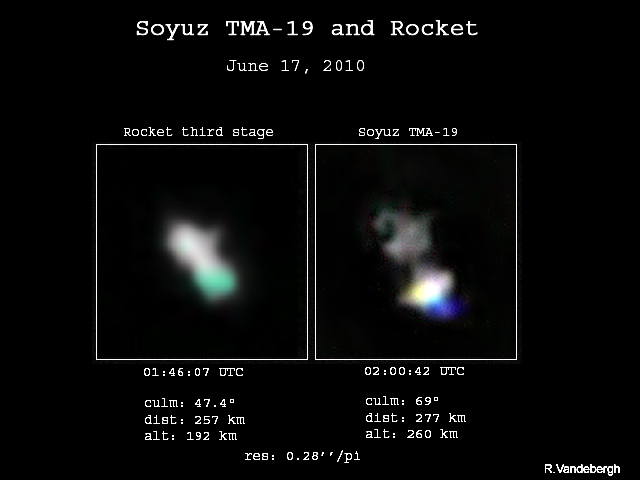
Soyuz TMA-19 and its Rocke Image 2010/06/17(UT)
Ralf Vandebergh
R.Vandebergh

| Ralf Vandebergh(250mm Newton) |
subject: 2010/06/17_Soyuz TMA-19 and its Rocket
The Soyuz TMA-19, just launched on Tuesday, captured with the third stage
of its Rocket, the last separated stage before the Soyuz reached orbit.
The Rocket passed about 15 minutes before the manned Soyuz, in a lower
orbit, causing a lower altitude above the horizon. Apparant speed of
the Soyuz and especially the Rocket was much higher then the ISS,
due to the lower orbit, and therefore a challenge for fully manually
tracking as I did. I never was able to capture a stage of the Soyuz
Rocket earlier, and I'm satisfied, you can clearly make out the
shape of the Rocket stage. Those Soyuz rockets are never long visible
cause they enter the Earth Atmosphere pretty fast.
The Soyuz either is never long visible as it docks quickly
to the ISS within 2 days after launch.
Imaging: 10inch Newtonian, manually tracked.
 subject: 2010/06/17_Soyuz TMA-19 and its Rocket
The Soyuz TMA-19, just launched on Tuesday, captured with the third stage
of its Rocket, the last separated stage before the Soyuz reached orbit.
The Rocket passed about 15 minutes before the manned Soyuz, in a lower
orbit, causing a lower altitude above the horizon. Apparant speed of
the Soyuz and especially the Rocket was much higher then the ISS,
due to the lower orbit, and therefore a challenge for fully manually
tracking as I did. I never was able to capture a stage of the Soyuz
Rocket earlier, and I'm satisfied, you can clearly make out the
shape of the Rocket stage. Those Soyuz rockets are never long visible
cause they enter the Earth Atmosphere pretty fast.
The Soyuz either is never long visible as it docks quickly
to the ISS within 2 days after launch.
Imaging: 10inch Newtonian, manually tracked.
subject: 2010/06/17_Soyuz TMA-19 and its Rocket
The Soyuz TMA-19, just launched on Tuesday, captured with the third stage
of its Rocket, the last separated stage before the Soyuz reached orbit.
The Rocket passed about 15 minutes before the manned Soyuz, in a lower
orbit, causing a lower altitude above the horizon. Apparant speed of
the Soyuz and especially the Rocket was much higher then the ISS,
due to the lower orbit, and therefore a challenge for fully manually
tracking as I did. I never was able to capture a stage of the Soyuz
Rocket earlier, and I'm satisfied, you can clearly make out the
shape of the Rocket stage. Those Soyuz rockets are never long visible
cause they enter the Earth Atmosphere pretty fast.
The Soyuz either is never long visible as it docks quickly
to the ISS within 2 days after launch.
Imaging: 10inch Newtonian, manually tracked.
 On June 17, one day after launch of the Soyuz TMA-19 with the expedition 24
crew on its way to the ISS, the 3rd stage of its rocket and the Soyuz itself
passed over the Netherlands. The apparant speed of the 2 objects was at that
time much higher then the ISS, due to its still lower orbit.
The rocket passed about 15 minutes before the Soyuz and was in a low orbit
of below 200km. When I inspected the frames of the rocket one obvious thing
I saw was a different position of the rocket over the short time during
its pass.
To be sure, this is not caused by any movement artefacts due to
the highspeed, I only used frames which show a clear elongated shape of the
rocket in the not-move direction.
About halfway the animation, we seem to look even towards the short
axis (long axis pointed to Earth)
Usually, different forces cause a rocket to tumbling after it separates
and is not longer stabilized and can free rotated in Earth orbit.
Beside magnetic field forces, especially with rockets below 200km altitude
like this one, they are influenced heavily by aerodynamic forces.
On June 17, one day after launch of the Soyuz TMA-19 with the expedition 24
crew on its way to the ISS, the 3rd stage of its rocket and the Soyuz itself
passed over the Netherlands. The apparant speed of the 2 objects was at that
time much higher then the ISS, due to its still lower orbit.
The rocket passed about 15 minutes before the Soyuz and was in a low orbit
of below 200km. When I inspected the frames of the rocket one obvious thing
I saw was a different position of the rocket over the short time during
its pass.
To be sure, this is not caused by any movement artefacts due to
the highspeed, I only used frames which show a clear elongated shape of the
rocket in the not-move direction.
About halfway the animation, we seem to look even towards the short
axis (long axis pointed to Earth)
Usually, different forces cause a rocket to tumbling after it separates
and is not longer stabilized and can free rotated in Earth orbit.
Beside magnetic field forces, especially with rockets below 200km altitude
like this one, they are influenced heavily by aerodynamic forces.
 [バンディバ:オランダ]
[Ralf Vandebergh:Neighbourhood of Maastricht Netherlands]
[バンディバ:オランダ]
[Ralf Vandebergh:Neighbourhood of Maastricht Netherlands] ALPO-Japan Latest ALPO-Japan Latest

 Oplanets Section Oplanets Section
2010/06/22 [_ISS with Progress M-05M]
| 2010/05/23 [USA-161 KH]
| |